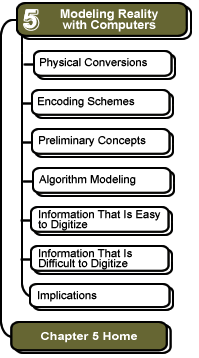

Information That Is Easy to Digitize
As we saw in the previous section, digital representations are based on the binary number system and provide a natural way to represent whole numbers. Relatively simple digital encoding schemes have also been devised for other forms of information, including:
- Letters and other characters
- Colors
- Images, Advanced: Color Tables
- Sounds
- Family Relationships
Consider the case of letters and other characters.
There are a number of possible character encoding schemes, the most common
of which is called the American Standard Code for Information Interchange
(ASCII). This code represents English letters (i.e., a is
represented by 1100001, b by 1100010), base-10 numerals
(i.e., 0 is represented by 0110000, 1 by 0110001), punctuation (e.g., a period
is represented by 0101110) and other special characters (e.g., a space is represented by 0100000). Most computers are able to
take a file of characters represented in ASCII and display them on the
screen in an understandable and legible manner. More
information on ASCII can be found at Wikipedia.
The title of this section refers to "relative" ease, because digital encoding is never trivial (except, perhaps for the case of representing the boolean values of true and false, which might seem trivial, but even there one has to decide if "true" is to be 0 or 1!). The development and use of any encoding scheme will entail value judgments and compromises. The ASCII encoding scheme, for example, was limited to 7 bits in order to reduce the size of ASCII-encoded files. This limitation, however, reduced the total number of possible characters to 27 (i.e., 128), which doesn't come anywhere close to handling other forms of writing such as Arabic, Sumero-Akkadian cuneiform, or Chinese. A newer encoding scheme, called Unicode, has emerged as the dominant international encoding scheme. This scheme will eventually support all the characters of all the world's languages, ancient and modern, but it has experienced many difficulties. More information on Unicode can be found at Wikipedia and at the Unicode homepage.
![]()
![]()
These pages were written by Steven H. VanderLeest and Jeffrey Nyhoff and
edited by Nancy Zylstra
©2005 Calvin University (formerly Calvin College), All Rights Reserved
If you encounter technical errors, contact computing@calvin.edu.